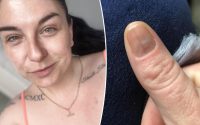Experts warn against dangerous DIY lip filler trend: ‘Traumatic’
In an effort to cut costs, women are using DIY injectables to plump their pout at home.
Online, TikTokers have touted their self-injections of hyaluronic acid, a commonly used filler, to the dismay of doctors everywhere.
One woman boasted that her lips “double in size for a cheaper price” while using an at-home injection hyaluron pen — which appears to be sold on eBay for about $40 depending on the vendor — while others demonstrate how to use the device.
The alarming beauty trend coincides with a rise in cosmetic procedures, especially among Gen Z. In 2022, hyaluronic acid filler injections accounted for 4,883,419 aesthetic procedures, a 70% increase from 2019.
A syringe can be costly — patients cough up an average of $684 for the dermal filler, according to the American Society of Plastic Surgeons — making an at-home, cost-effective method all the more alluring.
“I can understand that someone may see a product like this in a TikTok video, or they heard of a friend-of-a-friend who had a ‘good result,’ ” Cleveland Clinic plastic surgeon Martin Newman, based in Florida, said in a statement.
“Unfortunately, some folks will try something without doing their homework simply because someone else has done it first and had an acceptable outcome.”
The popularized, needle-less device uses compressed air to push the hyaluronic acid through the skin, which Newman said “sounds pretty traumatic.”
“The first question you really have to ask is: How can you push a dermal filler — whose physical properties are that of a viscous gel, like Jell-O — through the skin?” he mused.
While similar devices are effective in delivering medication or immunizations, experts warn that it is insufficient for dermal filler.
“My concern is that the procedure is not controllable,” Newman cautioned, adding that the injector cannot control how deep the hyaluronic acid is going.
“When doing a procedure like this, you need to have meticulous control over exactly where, what and how much you are injecting.”
Not to mention, the hyaluronic acid bought from online retailers may not be medical grade.
The Food and Drug Administration has previously warned consumers about the dangers of at-home dermal filler administration using needle-free devices.
Complications include blindness, stroke, death or decay of the tissue, bleeding, infection, scarring, skin lumps and discoloration.
“The FDA has not evaluated the safety and effectiveness of needle-free devices for injection of any dermal filler,” the agency stated. “The FDA also has not approved the marketing of needle-free devices for injection of these products.”


